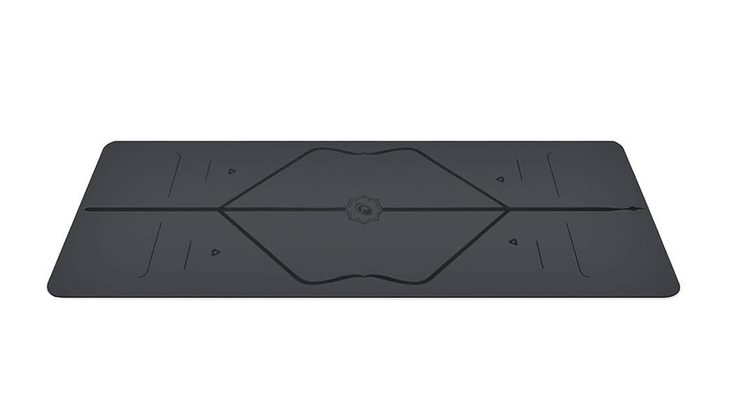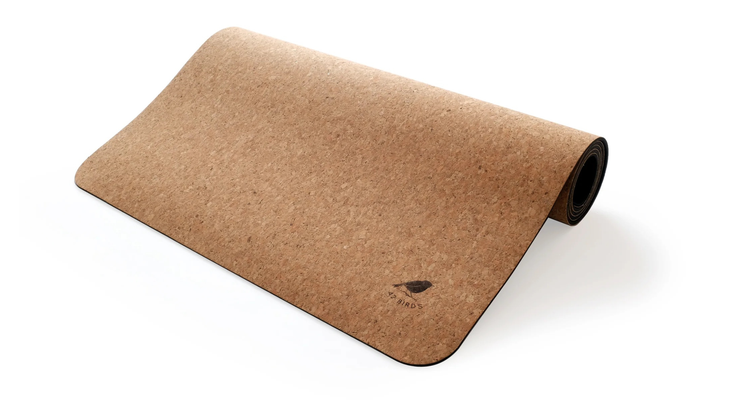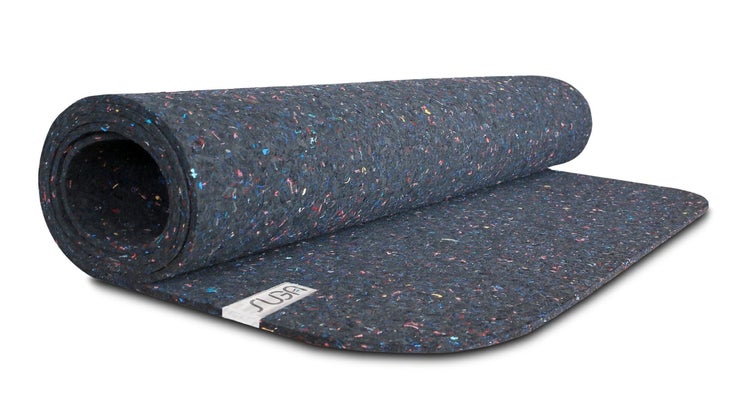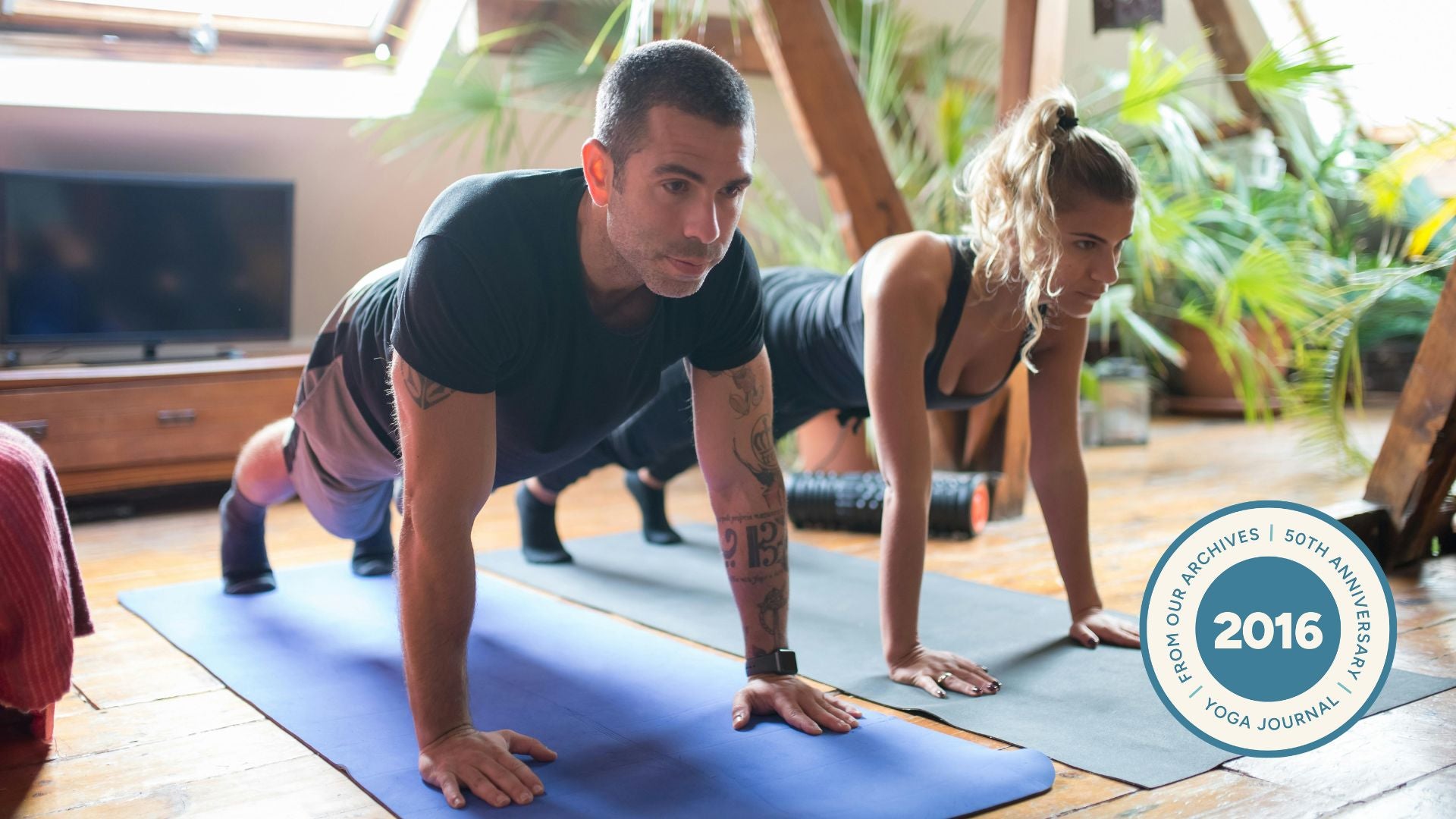“], “filter”: { “nextExceptions”: “img, blockquote, div”, “nextContainsExceptions”: “img, blockquote, a.btn, a.o-button”} }”>
Heading out the door? Read this article on the new Outside+ app available now on iOS devices for members!
>”,”name”:”in-content-cta”,”type”:”link”}}”>Download the app.
Maybe your foray into yoga mats was a flimsy little number you snagged for $20. It was during your initial fling with yoga, before you knew if you’d continue with it, and you wanted to minimize your losses in case you quit the practice. You ended up staying with yoga—and with your decidedly un-eco-friendly yoga mat. Eventually, you told yourself, you wanted to upgrade to something that better supports not only your practice but your planet. In the meantime, after practicing on your initial mat for months or years, you found that when you rolled up the disappointingly slippery, non-cushy, and chemical-laden item, it started to scatter flecks of foam like a baptism of unsustainability.
Sound familiar?
In recent years, there’s been no shortage of yoga mats that proclaim to be “eco-friendly” and “sustainable” and a lot of other Earth Day-savvy things. But it isn’t always obvious, at a glance, which brands not only take sustainability truly seriously but also deliver on the inexact algorithm of traits you seek in your mat. So we’ve done the research for you.
The following eco-friendly yoga mats rely on materials that are minimally harmful for you and for the environment. Many are also manufactured and packaged in sustainable methods, shipped via low-carbon methods, and play a part in supporting environmentally focused organizations. And yes, they also deliver on superlative grip, cushioning, stability, portability, or whatever else you appreciate in a mat, including (let’s be honest) aesthetics.
Below is a breakdown of each brand’s principles and the mat’s performance. Although we’re still on the search for more affordable options, in the meantime, we include mention of how you can save on the price of each.
At a Glance
All mats in this guide were tested by multiple reviewers. When you buy through our links, we may earn an affiliate commission. This supports our mission to get more people on their mats.
Most Eco-Friendly Yoga Mats

Sustainable Splurge: Liforme Classic Yoga Mat
Liforme $119 (usually $140) Amazon $150
Materials: Natural rubber base + eco-polyurethane surface
Thickness: 4.2mm
Weight: 5 1/2 pounds
Dimensions: 73 x 27 inches
Pros + Cons
⊕ Biodegradable
⊕ No toxic anything
⊕ Recyclable cardboard packaging
⊗ Smudges and scuffs sorta easily
Principles
A certified B Corp company, U.K.-based Liforme meets some lofty standards for environmental as well as societal accountability. The company’s trendy and iconic mat has a natural rubber base and a specially engineered eco-polyurethane surface (yes, there’s such a thing as eco-polyurethane). There are no toxic glues binding the layers together and all inks are non-toxic.
Also of note is the company’s larger commitment to sustainability, which is rarely talked about given the focus on the fashionable and functional mat. But the packaging is all recyclable cardboard, the shipping takes place by sea rather than air to reduce carbon emissions, and the company is a longtime partner of environmentally focused non-profits.
Performance
This trendy—and, let’s be honest, aesthetically lovely—mat has been increasingly showing up at studios stateside in recent years. Although the mat’s appeal is about so much more than looks, with it consistently drawing rave online reviews for its grip, even in the muggiest and sweatiest of hot yoga sessions. That grip, which was specially engineered, means there’s no mat wrinkling beneath you as you transition between front of the mat and back and you can linger in Down Dogs during a sweaty hot yoga class without fear of fearing you’re on a Slip’ n Slide.
Practically speaking, it’s slightly less thick than many yoga mats in this price category. That means slightly less material (yay eco-consciousness) although it feels slightly less cushioned than some mats (sigh if you struggle with sore knees). After practicing on it for months, we understand why one Redditor commented, “I bought a LiForme mat a couple of years ago after 20 years of practicing on whatever $20 mat, and it was an absolute game changer. No joke, best $150 I’ve ever spent.”
Eventually, the sweat will sorta smudge that lovely aesthetic. It also scratches sorta easily, so pet owners, beware leaving it unrolled and unattended. Still, you’ll get years and years out of it—as well as some enviable looks from others at the studio.
Price
PSA: All Liforme mats are currently discounted 30 percent through the end of Earth Month. Purchase a second mat and you’ll snag an extra 15 percent savings.
Read our full review of the Liforme Classic.

Soooo Sustainable: 42 Birds Cork Yoga Mat
Materials: Natural rubber base + 100-percent recycled natural cork surface
Thickness: 5mm
Weight: Less than 2 pounds
Dimensions: 72 x 26 inches
Pros + Cons
⊕ Sustainably sourced
⊕ Ethereally lightweight
⊕ Somehow makes cork seem elegant
⊗ Slightly slick when not sweaty
Principles
The fact that cork is sustainable, regenerable, and biodegradable is fairly well known. And there’s no shortage of cork yoga mat manufacturers out there. Yet there’s surprising variability among the mats they make. Unlike companies whose products’ only presence of cork seems a graphic cork design imprinted on rubber, 42 Birds finds an exemplary balance of lightweight cork with grippy natural rubber.
The company packages the mats in eco-friendly recyclable cardboard with a slick label that can be flipped and reused as wrapping paper. Named after the number of bird species that exist in the cork forests, 42 Birds has long supported environmental solutions through 1% for the Planet. It is donating one percent of its 2024 profits to the official nonprofit partner of the National Park Service, the National Park Foundation.
Performance
If you schlep your mat several city blocks or subway lines to class, this uber-lightweight option is definitely what you need. And if you appreciate cushiness and grip in a mat, then it’s definitely what you want.
The same cellular structure that makes the mat exceptionally airy also results in it being surprisingly supportive. But you’d be wrong to assume it’s delicate. In fact, we’re mystified as to how something so airy could also be so durable and unscathed after all the standing, transitioning, balancing, sitting, and reclining we brought it. As one online reviewer noted, “Not to be dramatic, but this is the yoga mat I’ve been looking for my whole life.”
As with most cork surfaces, it’s grippier when slightly wet, so a spritz of water will go a long way to help your hands and feet stay put.The cork will take on grime and smudges, so beware where you stash it, although the cork itself is antimicrobial so there’s little need to disinfect it. And yes, there’s a simple elegance to its bare look, even when rolled and tucked in the corner of your apartment to put your sustainable vibe on display.
The Robin also comes in extra-long—at an astonishing 85 inches in length—for $86. Prefer a little more cushiness? Opt for the Imperial Eagle with its thicker rubber base for $88.
Price
Purchases of more than $100 are currently discounted with code SAVE20.

Brilliantly Repurposed: Suga Recycled Wetsuits Yoga Mats
Materials: 100 percent recycled neoprene surf wetsuits
Thickness: 5mm
Weight: 5 pounds
Dimensions: 72 x 25 inches
Pros + Cons
⊕ Made exclusively from recycled wetsuits
⊕ Dense cushioning
⊕ Easy to clean
⊗ Different (but not bad!) textured vibe
Principles
You gotta love a company that not only keeps things out of a landfill but makes it recyclable—or, as the folks at Suga say, “reincarnated.” That’s how they refer to the process they engineered to “recycle these petrochemical based landfill clogging neoprene monsters into highly functional instruments of yogic bliss.”
Fittingly, one wetsuit equals approximately one yoga mat. And yes, you can donate your worn wetsuit to the cause, either via drop-off or shipping, in exchange for 10 percent savings. You can also volunteer to host a local wetsuit collection bin.
The mats are manufactured stateside according to U.S. environmental laws, and the lack of overseas shipping lessens the carbon footprint. Suga, whose name draws equally from “surf” and “yoga,” also shares a portion of gross revenues with environmental non-profits through 1% for the Planet. The brand explains its take on eco-consciousness, stating on its website, “If corporations are afforded personhood by law, we believe they should be held to the same ethical standards as humans.”
Performance
The textured surface is a little unprecedented in the yoga space yet the tackiness makes for a surprisingly grippy mat whether or not you’re sweating. The material is also reassuringly dense with a supportive thickness that ensures a cushy space to practice, whether you’re kneeling, arm balancing, or stretching out in Savasana. It also rolls out flat the first time you take it out of the (recyclable cardboard) box.
Although you might not see a lot of these in your local studio, Suga has an enthusiastic fan base with overwhelmingly appreciative online reviews for its concept as well as its practical application. We understand why.
The vibe can be a little reminiscent of the low, pre-shag carpeting you might have experienced in your grandparents’ house—but not in a bad way! Just remind yourself you’re practicing on a badass surfer’s wetsuit that was once drenched in the ocean. For an extra $10, you can land the extra-large version, which affords you an additional 2 inches in length and 1 inch in width.
Price
At some point, every sustainable mat will begin to break down. Consider the Cradle2Grave (C2G) option which, for $189, ensures a lifetime of free mat replacements.

Entirely Eco-Conscious: Manduka eKO Yoga Mat
Materials: 100 percent natural rubber
Thickness: 5mm
Weight: 7 pounds
Dimensions: 72 x 25 inches
Pros + Cons
⊕ Natural rubber sustainably sourced from non-Amazon trees
⊕ “Rippled” texture provides grip
⊕ No towel required for hot yoga
⊗ Not gonna last forever (or maybe even a couple years)
Principles
As a company, Manduka delivers an array of yoga mats that provide reliably dense cushioning and support made with eco-conscious materials that deliver the feel everyone wants in a yoga mat with the sustainability of eco-conscious materials. That’s not as easy as it might sound.
The eKO line of mats is perhaps most sustainably made of any of their mats, relying on recycled non-Amazon tree rubber in energy-efficient facilities and shipped without plastic packaging. It also features non-azo dyes, and no PVC or similar chemicals. According to the company, all scrap is re-used for a zero waste manufacturing process.”
Also, when you want to recycle your old mat, Manduka will send you a prepaid label as well as a coupon for 20 percent off, no matter what brand the mat.
Performance
There’s no denying how grippy the eKo mat is thanks to the surface texture, which can be described as “subtle wave or woodgrain or whatever.” It also means you can practice on it in the sweatiest of conditions and not need to throw down a towel, which is yet another subtle way to save resources and money.
The densely cushioned mat is also much more than superficial grip. As one of our testers explained, “Whenever I have to use an alternate mat, the difference is significant enough to piss me off.” As with all Manduka mats, the eKO comes in an array of imaginative colors, sizes, and thicknesses. Anyone who wants to minimize material can opt for the eKO Lite ($92), which is one less mm in thickness yet vastly more portable. It still retains all the other perks of the design.
The concern we read most consistently is the relative delicacy of its sustainable composition, which isn’t ideal for frequent usage, especially in hot yoga classes—a fact Manduka transparently cautions about on its site. Note the PRO or PROLite lines by Manduka, which are also made with natural rubber, are almost indestructible, and are a darling of yoga teachers for many reasons. Also, some online reviewers consider the functional textured design slightly distracting, whereas others deem it a “pretty elevation of a solid color.”
Price
Check the “Almost Perfect” portion of Manduka’s site, which brings you mats from various styles at substantial discounts due to ever-so-slight variances or, one could say, imperfections. That includes long and wide mats as well as the PRO and PRO Litee lines.

Best OG: Jade Harmony Yoga Mat
Materials: Natural rubber. That’s it.
Pros + Cons
⊕ Literally nothing but natural rubber. No PVC or phthalates.
⊕ Intense grip
⊕ Available in extra-long and extra-wide
⊗ Textured surface also attracts fuzz and fur
⊗ Shows wears with sustained practice
Principles
Jade is the brand that largely launched the sustainable yoga mat movement in 2000. The only material used in the stateside manufacturing of the mats is the renewable resource of natural rubber. Also, since 2006, the company has planted one tree for each mat sold, totaling more than two million saplings on the planet, a practice that has inspired many other brands to follow. It also donates 10 percent of online Earth Day sales to environmental organizations.
Performance
Jade Yoga seems to be founded on the simple premise that simple works. As defined here, simple means natural rubber mats in enviable jewel tones that are available in slight variances in thickness and dimensions.
The mats also have the same “unearthly” grip, as one tester described the textured surface. “Imagine you had Alien Tape suction cupping your hands and feet to the mat.”
Many yoga teachers prefer the “support, grip, and cushion,” as one tester described it. That grip can feel almost claustrophobic for some who maybe are a touch more avoidant when it comes to such commitment to a position on a mat. Over time, the mat will show wear and tear from holding you so closely, requiring it to be replaced.
The Harmony has a 5mm thickness and is sturdy but less nondescript than most yoga mats owing to the array of muted but rich colors. Another sustainable option is the recycled sari yoga rug made from cotton.
Read our full review of the Jade Harmony.
Price:
Jade mats occasionally go on sale. The company also donates 10 percent of online Earth Day sales to environmental organizations, so if you’re trying to do something for the environment, you can do a little more by buying on that day.
What You Need to Know About Materials in Eco-Friendly Yoga Mats
When you Google “sustainable yoga mats,” you encounter mention of two primary materials—natural rubber and cork—as well as how they compare to synthetic rubber. It’s a complex topic with no simple solutions, so essentially, your decision comes down to an inexact algorithm of traits that are important to you.
Natural Rubber
Unlike its inexpensive synthetic rubber counterpart, natural rubber is derived from rubber trees and contains no PVC, chemicals, or toxins. It may potentially contain trace amounts of latex. The process does not cause toxic runoff into water or soil (or, for that matter, into the air you breathe) and the resulting material is biodegradable. The trees are not felled during the extraction process, although they can be damaged and the industry can lead to deforestation—and its accompanying ecological crises.
Natural rubber is commonly used for eco-friendly yoga mat, whether as the only material or as a base layer. It is recyclable although not all local curbside recycling processes it.
Cork
The making of cork relies on removing the bark of a particular oak tree once it reaches a certain age. It causes no damage to the trees, which regenerate the bark every 9 to 12 years and can withstand multiple cycles of surrendering bark in a lifetime. Curiously, cork trees actually absorb carbon dioxide, which means the process of manufacturing cork can be carbon positive, making it an even more renewable and sustainable process. Cork is biodegradable and recyclable, although similar to natural rubber, local recycling plants don’t always process it.
How We Tested
- Mats tested: 38
- Testers: 18
- Number of classes practiced: Hundreds
- Skinned knees: 1
- Splinters from unfinished cork (not 42 Birds): 1
- Gasps of surprise: 5+
We’re sorta obsessed with yoga mats. We’re continually perusing online reviews for mat, inundating complete strangers at yoga studios with questions about their mats, and randomly asking the yoga teachers we know to divulge everything about the mats they’re in a long-term relationship with and why. We’re constantly geeking out about stability, grip, cushiness, durability, ease of cleaning, and other features that you can only truly appreciate—or curse—after practicing on the same mat for months or years.
Every once in a while, we narrow down the mats we feel are top contenders—whether new styles or old, big-name brands or boutique label—in all price points and ask our group of 18 students and teachers of yoga—millennials and near-octogenarians, hot yoga goers to yin and restorative regulars, novices and decades-long teachers—to make these mats part of their regular yoga routine for a few weeks.
Then we asked questions. Lots and lots of questions.
In determining our best eco-friendly yoga mats, we kept in mind the materials, manufacturing practices, packaging, user experience, and price versus value. What this looks like varies dramatically from brand to brand. And then we practiced some more. What you see above are our results.
How to Find the Right Eco-Friendly Yoga Mat for You
Still undecided? If your current mat isn’t falling apart, perhaps the most sustainable decision you can make at the moment is to continue practicing on it. Then when it starts to wear and you’re ready to replace it with an eco-friendly yoga mat, explore the options above again. And don’t forget to recycle or reuse your old mat.
Everything You Need to Know About Yoga Mats
The Best Yoga Mats for Literally Everyone
The Best Way to Clean Your Yoga Mat
How Often Should You Clean Your Yoga Mat?
What to Do With Your Old Yoga Mat (Including Unexpected Ways to Reuse It)







